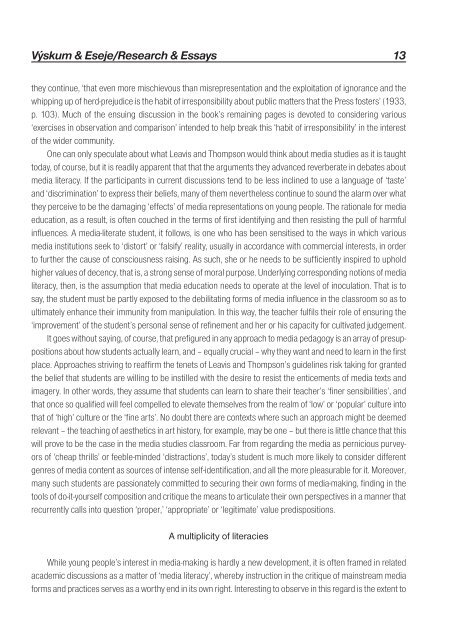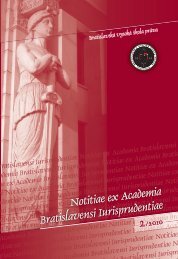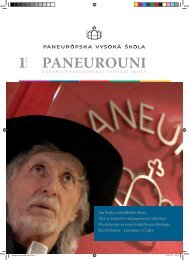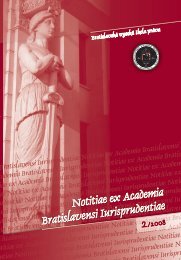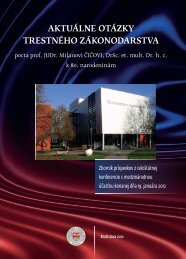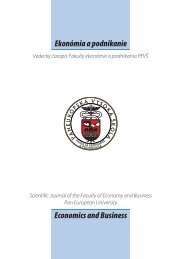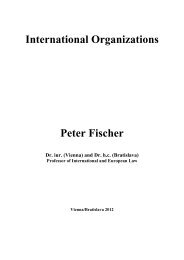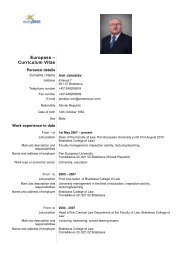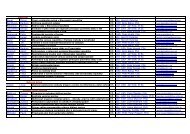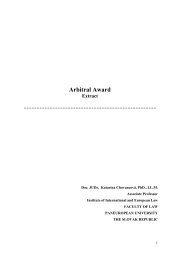ÄÃslo 1/2013 - Paneurópska vysoká Å¡kola
ÄÃslo 1/2013 - Paneurópska vysoká Å¡kola
ÄÃslo 1/2013 - Paneurópska vysoká Å¡kola
Create successful ePaper yourself
Turn your PDF publications into a flip-book with our unique Google optimized e-Paper software.
Výskum & Eseje/Research & Essays 13<br />
they continue, ‘that even more mischievous than misrepresentation and the exploitation of ignorance and the<br />
whipping up of herd-prejudice is the habit of irresponsibility about public matters that the Press fosters’ (1933,<br />
p. 103). Much of the ensuing discussion in the book’s remaining pages is devoted to considering various<br />
‘exercises in observation and comparison’ intended to help break this ‘habit of irresponsibility’ in the interest<br />
of the wider community.<br />
One can only speculate about what Leavis and Thompson would think about media studies as it is taught<br />
today, of course, but it is readily apparent that that the arguments they advanced reverberate in debates about<br />
media literacy. If the participants in current discussions tend to be less inclined to use a language of ‘taste’<br />
and ‘discrimination’ to express their beliefs, many of them nevertheless continue to sound the alarm over what<br />
they perceive to be the damaging ‘effects’ of media representations on young people. The rationale for media<br />
education, as a result, is often couched in the terms of first identifying and then resisting the pull of harmful<br />
influences. A media-literate student, it follows, is one who has been sensitised to the ways in which various<br />
media institutions seek to ‘distort’ or ‘falsify’ reality, usually in accordance with commercial interests, in order<br />
to further the cause of consciousness raising. As such, she or he needs to be sufficiently inspired to uphold<br />
higher values of decency, that is, a strong sense of moral purpose. Underlying corresponding notions of media<br />
literacy, then, is the assumption that media education needs to operate at the level of inoculation. That is to<br />
say, the student must be partly exposed to the debilitating forms of media influence in the classroom so as to<br />
ultimately enhance their immunity from manipulation. In this way, the teacher fulfils their role of ensuring the<br />
‘improvement’ of the student’s personal sense of refinement and her or his capacity for cultivated judgement.<br />
It goes without saying, of course, that prefigured in any approach to media pedagogy is an array of presuppositions<br />
about how students actually learn, and – equally crucial – why they want and need to learn in the first<br />
place. Approaches striving to reaffirm the tenets of Leavis and Thompson’s guidelines risk taking for granted<br />
the belief that students are willing to be instilled with the desire to resist the enticements of media texts and<br />
imagery. In other words, they assume that students can learn to share their teacher’s ‘finer sensibilities’, and<br />
that once so qualified will feel compelled to elevate themselves from the realm of ‘low’ or ‘popular’ culture into<br />
that of ‘high’ culture or the ‘fine arts’. No doubt there are contexts where such an approach might be deemed<br />
relevant – the teaching of aesthetics in art history, for example, may be one – but there is little chance that this<br />
will prove to be the case in the media studies classroom. Far from regarding the media as pernicious purveyors<br />
of ‘cheap thrills’ or feeble-minded ‘distractions’, today’s student is much more likely to consider different<br />
genres of media content as sources of intense self-identification, and all the more pleasurable for it. Moreover,<br />
many such students are passionately committed to securing their own forms of media-making, finding in the<br />
tools of do-it-yourself composition and critique the means to articulate their own perspectives in a manner that<br />
recurrently calls into question ‘proper,’ ‘appropriate’ or ‘legitimate’ value predispositions.<br />
A multiplicity of literacies<br />
While young people’s interest in media-making is hardly a new development, it is often framed in related<br />
academic discussions as a matter of ‘media literacy’, whereby instruction in the critique of mainstream media<br />
forms and practices serves as a worthy end in its own right. Interesting to observe in this regard is the extent to<br />
GMJ Book.indb 13 21.1.<strong>2013</strong> 9:44


